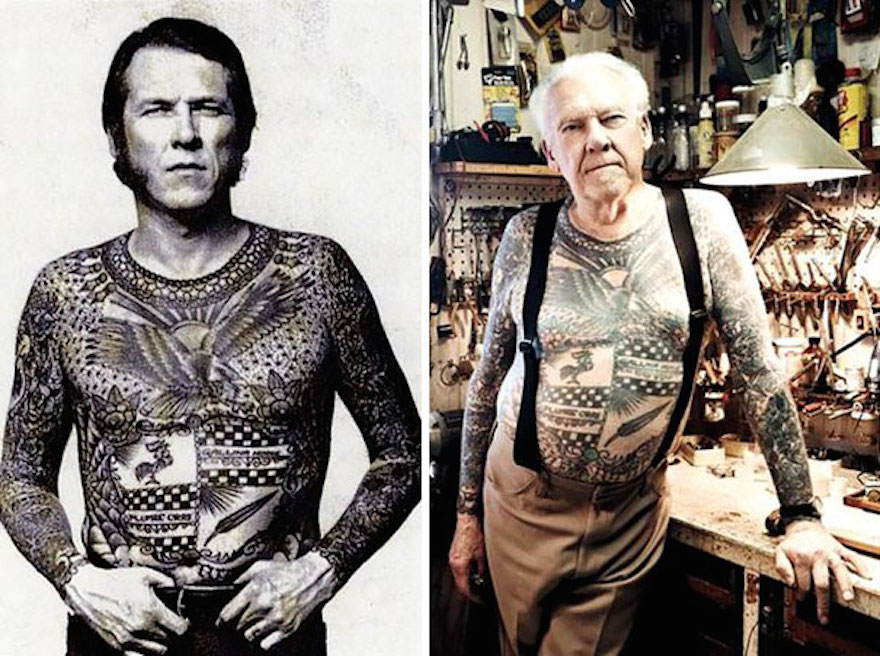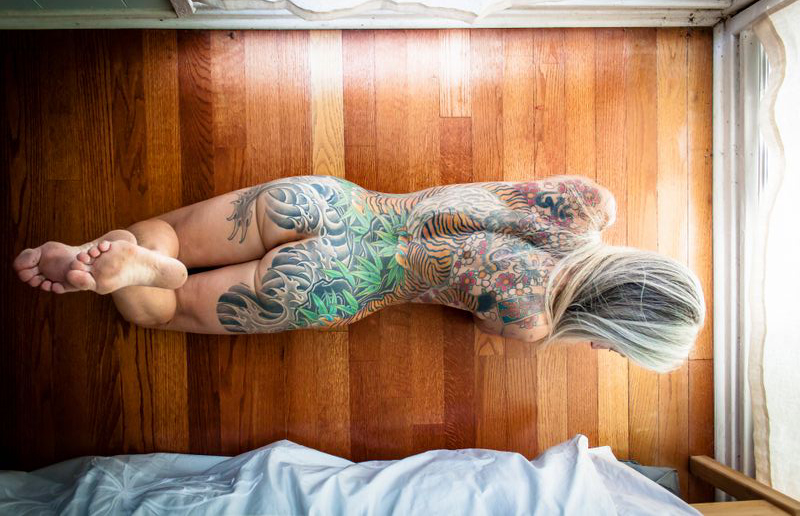Which one of us hasn’t heard something along the lines of „Think of your tattoos when you’re old and your skin droops and…?“ This is asked both as a preventative argument and of already tattooed people. It’s one of the classic ’buts’ of getting tattoos.
To alleviate this ’but’ for you a little, let’s analyze the effects of time on your tattoo and what could be done to minimize them.
1.
Colors, contrast and dulling
We should begin from the fact that today’s tattoo inks have exponentially improved compared to predecessors from 50, 20 or even 10 years ago. Since dye producers are facing strong competition, it is possible to better produce quality inks that last long with the correct care. I stress: with the correct care.
Last-century paintings that can be seen to deteriorate over time come from an age of different inks. Not only was the general quality different, but also colors and tools used in prisons and other similar environments.

So what is the correct care for colors? A tattoo’s worst enemy is intense sunlight.
The ABC of tattoo care includes wearing sunscreen with strong UV protection when going out in the sun. If you haven’t been an eager user of sunscreen so far, please use it on your tattoos anyway. Tattooed skin should be hydrated and nourished because dry skin doesn’t compliment it.
Since black tattoos absorb more sunlight, they dull a bit faster in the sun than colorful images. A colorful tattoo may be more receptive to general wear and skin renewal depending on tone and style, such as for the nuanced and delicate.
However, to be repeated that for both tones, the composition of dyes has improved over the years and promises better durability with the right care.
It might be comforting to note that a touch-up can be done if a tattoo has dulled for any reason. A refreshed tattoo is radiant even after years of wear.

2.
Fading
Tattoos are technically part of your skin and will change with it. Whatever your skin loves will wonderfully impact how striking your tattoo looks.
Acting in an educated manner will help preserve your tattoo over the years. But decades? Factors that change the appearance of a tattoo in the long term can be separated into two categories:
- Natural aging of the skin
- External factors and tattooed skin care

Natural aging of the skin may slightly alter the appearance of a tattoo.
Aged skin is thinner, looser and less elastic. The surface is more dry and sensitive and needs more moisturization and care. Wrinkles, stretch marks and extra skin are more likely to occur.
For a tattoo, whose ’screen’ is skin, looseness may lead to a change in shape, like cracks on a television screen or a stretched out image.
But aging doesn’t take place overnight and everything comes down to how you protect your tattoo from external factors and also how healthy of a lifestyle you lead. A varied diet and adequate water intake affect a tattoo’s appearance.
Tattoos also fade due to natural skin cell renewal. However, that is a very lengthy process and a good skin care routine will minimize change for a long time.
As previously mentioned, UV-radiation fades tattoos, and that includes tanning beds.
A tattoo’s lifespan is affected by how much friction it is exposed to: this should be taken into account when choosing placement and according to your lifestyle. Everything that encourages skin aging will also speed up tattoo fading. Smoking and alcohol abuse are among those activities.
Both new and very old tattoos require mosturizing, nourishing and sun protection to prevent further fading. It is especially important in our cold climate, where skin gets dry easily. Lotions with collagen and vitamin E are recommended.
Sunburn should be avoided at all costs.

3.
Weight change
Weight change is related to aging for two reasons: firstly, changes in metabolism can affect weight and secondly, skin gets more brittle with age and may not be able to keep up. This can distort a tattoo.
The stomach, upper arms, thighs and buttocks are typical regions where rapid weight change is more likely to deform a tattoo.
If you have ever deflated a balloon, you can probably imagine what happens to very small features. Something similar can happen with small tattoos and details. Larger elements generally withstand weight loss better.
Losing weight slowly and steadily is in the interests of tattooed skin, so the skin could keep up with the tattoo. It is reasonable to avoid extreme diets and choose a moderate path of fitness and healthy eating. Drink plenty of water to help skin catch up and avoid looseness.

Gaining extra weight is also not excluded when it comes to aging. Changes in metabolism can contribute to obesity in certain areas. It is important to know that sudden weight loss generally distorts a tattoo more than weight gain. Tattoos can stretch and change shape, especially when it comes to more intricate patterns.
The brittleness of aging skin may cause stretch marks and damage tattoo design. To avoid these consequences, increases in fat percentage should ideally be kept at a slow pace. This is also helped by sufficient water intake and skin moisturization (adequate hydration around the tattoo).
4.
Tattoo detail
Long-term tattoo preservation depends on how many small details it has. Small and detailed designs fade more than works consisting of larger elements.
If you are still planning on a detailed tattoo, the artist may propose upsizing your initial design. One of the reasons is the same resistance to fading and when it does dull, oh how much simpler and cheaper it will be to fix it up.

5.
Tattoo placement
The location and lifespan of a tattoo are mainly related via sunlight and friction.
Tattoos on shoulders, chest and upper back are the main victims of sunlight.
Areas that catch less sunlight and therefore last longer include inner arms, thighs, stomach and back (obviously depending on your habits).
Friction can properly wear out tattoos that are in constant contact with the rest of the body or clothes. For example inner fingers, inner thighs (walking) and feet (wearing and taking off shoes).

In conclusion, although aging does affect your tattoos, proper care can slow it down. Care includes sunscreen, moisturizing, avoiding friction and a healthy lifestyle, to slow down the aging of skin. Slow aging of a tattoo is natural and it can be retouched.
Before getting a tattoo, colors, size, amount of detail and placement must be considered.
Caring for yourself and your health doesn’t only improve your wellbeing and appearance, but also the look of your tattoos. It’s important to listen to your tattoo artist, for example if they think a tattoo is too small and should be upsized.

